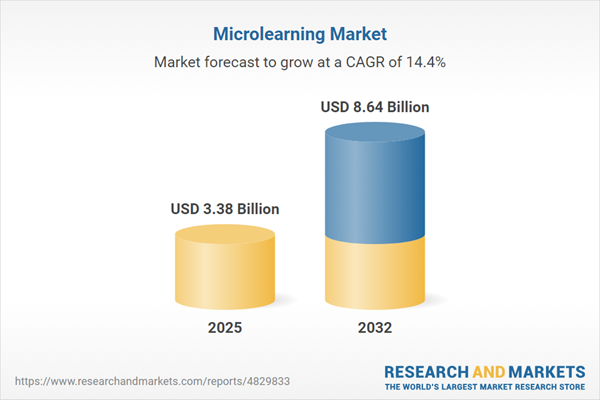Speak directly to the analyst to clarify any post sales queries you may have.
Microlearning is rapidly redefining how enterprises deliver scalable and agile workforce training. Senior decision-makers are leveraging microlearning solutions to enable flexible skills development that meets the evolving demands of a fast-paced business environment, resulting in continuous workforce performance improvement.
Microlearning Market Snapshot
The microlearning market expanded from USD 2.95 billion in 2024 to USD 3.38 billion in 2025, achieving a CAGR of 14.37%. By 2032, the market is projected to reach USD 8.64 billion. This robust trajectory shows a strong organizational preference for digital learning platforms offering cost-effective, scalable training. Enterprises are adopting microlearning to accelerate upskilling, create operational efficiencies in training delivery, and increase adaptability to workplace shifts. Demand is being driven by the need for tools that optimize learning experiences for both on-site and distributed teams within a strictly regulated and results-focused business climate.
Scope & Segmentation of the Microlearning Market
- Content Types: Gamification, micro lectures, multiple choice exercises, short answer interactions, true/false quizzes, simulations, interactive video, standard video, and virtual reality. Each format is designed to address priority needs, from compliance-driven instruction to engaging, role-specific skill development in complex work scenarios.
- Deployment Modes: Cloud-based models and on-premises infrastructure. Cloud solutions enable scalability and broad access, while localized on-premises deployments reinforce security and align with stringent data-handling requirements in regulated sectors.
- Industry Verticals: BFSI, healthcare and life sciences, IT and telecom, retail and e-commerce. These verticals drive unique adoption strategies—for example, compliance requirements in healthcare contrast with the need for rapid adaptation in retail, shaping how solutions are integrated.
- End Users: Corporates, educational bodies, government entities, and healthcare organizations. Corporates emphasize seamless onboarding and continuous role alignment, while the public sector and healthcare prioritize standards, traceability, and verifiable certifications in training delivery.
- Device Types: Desktop and mobile learning platforms. Responsive solutions ensure accessibility, while options for offline usage accommodate mobile and field-based personnel for uninterrupted learning.
- Regions Covered: Americas (including North America and Latin America), Europe, Middle East & Africa (the UK, Germany, France, Saudi Arabia, South Africa), and Asia-Pacific (China, India, Japan, Australia, and other leading players). Adoption rates and technology configurations reflect differing infrastructure maturity, legal frameworks, and regional localization needs.
- Key Companies: Skillsoft, LinkedIn, Udemy, Docebo, SAP, Degreed, Axonify, Qstream, SafetyCulture, and eduMe. Their offerings span the enterprise training ecosystem, supporting a broad set of workforce requirements from compliance to advanced upskilling.
Key Takeaways: Strategic Insights for Decision-Makers
- The integration of microlearning with existing talent management and HR frameworks strengthens the link between training efforts and organizational objectives, supporting streamlined workforce development strategies.
- Customizable learning pathways, enhanced by adaptive algorithms and artificial intelligence, enable targeted training that addresses unique skill gaps, improving outcomes and user engagement.
- Advanced content features such as interactive video and virtual reality drive higher retention and facilitate real-world scenario practice, equipping teams for immediate workplace application.
- Increased collaboration among content designers, technology vendors, and device manufacturers is fueling rapid solution innovation, resulting in more adaptable training resources.
- Local language support, compliance with specific regulations, and the maturity of IT infrastructure determine how quickly organizations implement and scale microlearning platforms.
- Ongoing needs for structured reporting, auditability, and sector-specific certifications continue to influence how solutions are designed, selected, and integrated across regions.
Tariff Impact on Microlearning Solutions
Recent shifts in United States tariff policy are influencing hardware costs, particularly for immersive learning features. Enterprises and service providers are managing this by diversifying hardware sources, localizing assembly processes, and revising pricing structures. This approach supports ongoing budget control, safeguards training investments, and strengthens supply chain reliability while ensuring compliance with evolving regulatory expectations.
Methodology & Data Sources
This report combines secondary research with primary interviews involving senior leadership, instructional designers, implementation partners, and end users. All findings are subject to multi-source triangulation and expert review, providing robust validation of market directions and actionable trends.
Why This Report Matters
- Enables decision-makers to align microlearning initiatives with business goals and workforce priorities for measurable value.
- Supports executive leaders in managing risk, ensuring compliance, and deploying secure digital learning infrastructure at scale.
- Delivers segment-specific insights to help prioritize investment and tailor strategies to local market conditions and rapidly changing talent requirements.
Conclusion
Microlearning equips organizations to respond to changing workforce needs, supporting smarter skills development and risk mitigation. This report offers the market intelligence leaders need to strengthen capability and drive innovation for future growth.
Additional Product Information:
- Purchase of this report includes 1 year online access with quarterly updates.
- This report can be updated on request. Please contact our Customer Experience team using the Ask a Question widget on our website.
Table of Contents
3. Executive Summary
4. Market Overview
7. Cumulative Impact of Artificial Intelligence 2025
List of Figures
Table Information
| Report Attribute | Details |
|---|---|
| No. of Pages | 180 |
| Published | October 2025 |
| Forecast Period | 2025 - 2032 |
| Estimated Market Value ( USD | $ 3.38 Billion |
| Forecasted Market Value ( USD | $ 8.64 Billion |
| Compound Annual Growth Rate | 14.3% |
| Regions Covered | Global |
| No. of Companies Mentioned | 11 |









